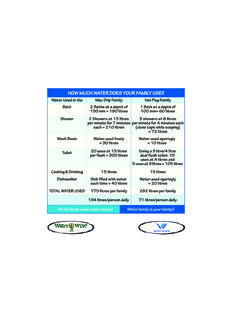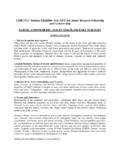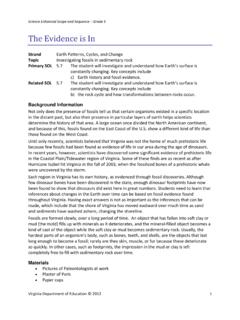Transcription of Poster 8 Lesson Notes - waterwise.co.za
1 Wetland RehabilitationPoster 8 Lesson NotesNotes for the EducatorCongratulations on obtaining your Water Wise education Notes from Rand Water. The following Notes focus on WETLAND REHABILITATION and explain the concepts displayed in the Poster , and include activities that can be done as school activities or as part of a training course. The Notes have been designed to be adaptable to various learning groups. The con-tent can either be expanded upon for the more advanced groups or condensed for groups that need only the basic concepts. The trainer can adjust the material ei-ther up or down depending on the target audience.
2 The pack is aimed at Grade 9 learners in the senior phase, with particular focus on the Natural Science learning area. The facilitator should first determine the group s needs, desired learning outcomes and the resources available. They can then decide how best to use the Poster and Notes . The Notes include suggested activities that tie in with the outcomes based education (OBE) system. The content and activities also touch on the critical and development outcomes found in our 1 Wetlands defined 2 - Importance of wetlands 2 - Wetland classification 2 - Wetland types 3 - Water transfer mechanisms 5 Function of wetlands 5 Wetland destruction 6 Benefits and uses of wetlands 6 - Recreational uses 6 - Medicinal properties 7 - Food 8 Want to know more 9 Wetland plants 10 - Growth conditions within wetlands 10 - Hydrophytes 10 - Wetland plant types 10 - Types of hydrophytes 11 - Wetland plants 12 - Wetland wildlife
3 12 - Food chain 13 Artificial wetlands 16 Managed wetlands 16 Impacted wetlands 17 - Types of impacts 17 Ramsar convention 19 Rehabilitation 19 - Methods of rehabilitating wetlands 20 - Reclaim the drains 20 - Stabilise the banks of rivers 21 - Monitor to make a difference 23 - Principles of successful wetland rehabilitation 23 - Grasses 23 Poster 8 Lesson 1 INTRODUCTIONW etlands have many benefits to society. Many wetlands in South Africa have been destroyed to make way for agricultural and residential development and through degradation.
4 Action needs to be taken to conserve and rehabilitate wetlands. In a water-stressed country such as South Africa the continued destruction of wet-lands will result in lower agricultural productivity, reduced clean water, less reli-able water supplies and increased downstream flooding. It will also result in plant and animal resources becoming more and more threatened. Wetland Rehabilitation - Poster 8 - Lesson 1 - Page 1 Wetland RehabilitationNumbers on the Poster correspond with numbers in Lesson notesDefinitionsEcosystem: a group of plants, animals and other organisms in- teracting with each other and with non-living components of their environment.
5 Anaerobic: no molecular oxygen present. Classification: the grouping of items (for example habitats or natural features) into categories with similar characteristics, properties or DEFINEDAny land that is wet for more than two weeks of the year down to a depth of 50 cm is a wetland. Wetland plants rooting zone is 50 cm and only they can endure saturat-ed conditions for longer than two weeks. Different wetlands have their own special vegetation types, like reeds and underwater plants. Some wetlands are constantly wet and under water, while others are temporary pans which dry up at certain times of the year.
6 Others are simply areas of waterlogged soil where the water lies just below the surface. Wetland areas have a high diversity of plants and animals, and are among the Earth s most productive word wetland is given to a variety of ecosystems, ranging from rivers, springs, and seeps in the upper 1 catchment; to midland marshes, ponds and floodplains; to coastal lakes, mangroves and estuaries at the bottom of the catchment. These ecosystems are all driven by water. The prolonged presence of water determines soil characteristics, and plant and animal species composition. Any area that expe-riences a prolonged period of wetness that over time affects the plants, animals and soil type that occurs there is defined as a wetland.
7 The South African National Water Act defines a wetland as land which is transi-tional between terrestrial and aquatic systems where the water table is usually at or near the surface or the land is periodically covered with shallow water, and which land in normal circumstances supports or would support vegetation typi-cally adapted to life in saturated soil. Wetlands must have at least one of the following attributes:Soil that displays characteristics of prolonged saturation; Water loving plants (even if occasional); High water table that results in saturation at or near the surface, leading to an- aerobic conditions developing in the top 50 cm of the importance of wetlandsStore water and release it during dry periods Purify water Erosion control Recreational use Recharge groundwater Regulate floodwater and streams (Summer: hold back, Winter: release) Conserve special plants and animals Environmental education Wetland classificationWetlands may be classified biologically, physically or chemically.
8 Features com-monly used to classify wetlands are the vegetation, hydrology, water chemistry, origin of water, soil types, landscape position and landform, origin of water source and wetland size.(Tiner, 1999. Wetland Indicators. A Guide to Wetland Identification, Delineation, Classification, and Mapping) Wetland Rehabilitation - Poster 8 - Lesson 1 - Page 2 Wetland Rehabilitation - Poster 8 - Lesson 1 - Page 3 DID YOU KNOW?Hydrology is the study of the movement, distribution and quality of water through out the Earth. It includes the hydrological cycle and all water resources. Wetland typesThe most common wetland types are:Floodplain;1.
9 Valley bottom channelled and un-channelled;2. Hill slopes with seepage or without seepage;3. Depressions or pans and oxbow lakes;4. Riverine (next to a river);5. Marshes;6. River;7. 13452678 Match the term with the Rehabilitation - Poster 8 - Lesson 1 - Page 4 Term 1. Rivers 2. Estuaries3. Peatlands4. Floodplains5. Lakes6. Marshes7. Ponds8. Sponges9. Springs 10. Swamps11. Vleis12. Artificial wetlandsDescription a. Carry water from the higher grounds to the Water bodies where the middle part is too deep for rooted plants to grow. c. Storage dams and sewerage ponds built especially for cleaning waste Places where water bubbles out of rocks or sand, often the start of a Occur where rivers meet the sea.
10 They are important feeding and breeding places for birds and Spongy waterlogged soil with tall emer-gent vegetation, like reeds and sedges. Many estuaries have salt Places where trees grow with their roots covered in fresh or sea Soft, boggy land high in mountains, the source of Low-lying areas where the rivers flood across the land after heavy An Afrikaans term South Africans use to describe any pond or Shallow water with some plants growing across or under Have spongy, waterlogged soil with moss, reeds, grasses and sedges growing in them. The plants decay over time to form peat.














